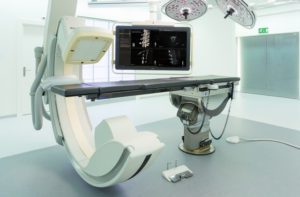
Philips’ augmented reality surgical navigation technology is designed to help surgeons perform image-guided open and minimally-invasive spinal surgery. [Image from Philips]
Philips, the technology company that has shifted its focus toward healthcare innovation, is one of the major companies in image-guided therapy products and services and continues to bring new technologies to market. Headed by CEO Bert van Meurs, Philips Image Guided therapy focuses on interventional devices such as its Azurion imaging platform for low-dosage X-rays and its augmented reality (AR) surgical navigation technology.
“The challenge is now how do we grow as a business and to continuously look at these new opportunities, and there we are in an environment where these new non-invasive procedures are growing,” said van Meurs.
Philips is also invested in helping health practitioners provide care at a lower cost, according to van Meurs. How can Philips integrated solutions provide strong economic value while staying at the forefront of new clinical procedures?
“It is important to stay at the forefront of these … new clinical developments and come up with new innovations to imaging that make these procedures more efficient, more effective and help to advance these new procedures,” said van Meurs. “While at the same time, the main challenge that you see today in the market is not only from a clinical perspective. That’s how we work very close together with clinicians, with the radiologists and cardiologist in the leading institutes to develop these new clinical tools, but also if you now look today, especially in the U.S. as well as in Europe, the demand from hospitals is not so much only on advancing clinical value, but especially looking at economical value.”

Bert van Meurs, CEO of Philips Image Guided Therapy [Image from Philips]
Image-guided therapy in the changing healthcare system
The healthcare system has undoubtedly been facing a number of changes since the Affordable Care Act (ACA) was signed into law in early 2010. Obamacare significantly reduced the number of uninsured in the U.S. It expanded coverage, held insurance companies accountable, lowered healthcare costs and spending, and gave more choices and improved the quality of care for Americans, according to an article relayed by the Centers for Medicare and Medicaid Services.
Image-guided therapy plays into the quality of care for patients and the personalization of healthcare. Philips is working closely with the healthcare system and care providers to help redefine the way healthcare is delivered to patients by offering a more personalized system in an efficient way. It is using its coronary IVUS, pressure and flow based technologies to help deliver more personalized treatment of patients. These different product offerings give clinicians the chance to use different types of therapy that are unique to different types of patients.
“You need to have a treatment that is designed specifically for that patient because a specific treatment may be effective for one patient but may not be, depending on the situation, in another patient,” said van Meurs.
“The trend for image-guided therapy for minimally-invasive treatment is especially that – where it is replacing open surgery, … which is of course more expensive and a much larger impact on a patient,” said van Meurs. “Therefore you have now these procedures you can do with minimal impact and less trauma, and for many of these procedures, patients can actually leave the hospital the same day.”
Bringing augmented reality into play
The AR surgical navigation technology is designed to help surgeons perform image-guided open and minimally-invasive spine surgery. Using high-resolution optical cameras that attach to the flat panel X-ray detector that images the surface of the patient, the AR system creates a 3D view of the patient’s anatomy when combined with external images.
The 3D images of the patient’s spine help improve procedure planning and operation times, surgical tool navigation and implant accuracy. Where spinal surgery is usually an open surgery procedure with large incisions for surgeons to see the spine, AR helps surgeons make smaller incisions by giving them insight into where to insert pedicle screws with 85% accuracy. Non-AR surgical navigation only has 64% accuracy.
Surgeons can also check the result in 3D in the operating room without moving the patient to a CT scanner and without exposing the surgeon to radiation and only administering a minimal dose to the patient.
What’s next for Philips?
Philips isn’t just going to develop an image-guided therapy and move on to the next innovation. It wants to continue to improve these innovations. One of the main things it wants to do is develop a better X-ray system that can reduce X-ray radiation.
The company is going to “continue to invest in the core technologies we already have,” said van Meurs. This includes the imaging, intravascular imaging and Azurion platforms.
Philips also wants to “go more into guidance and navigation technologies that can help to steer these devices better and to be more precise and deliver treatments” in the future, said van Meurs.
He also mentioned that Philips wants to be able to treat patients more efficiently and more effectively at a cost-effective value.
“It’s not only about the clinical advancement, but also about the economical value proposition,” said van Meurs.
[Want to stay more on top of MDO content? Subscribe to our weekly e-newsletter.]




